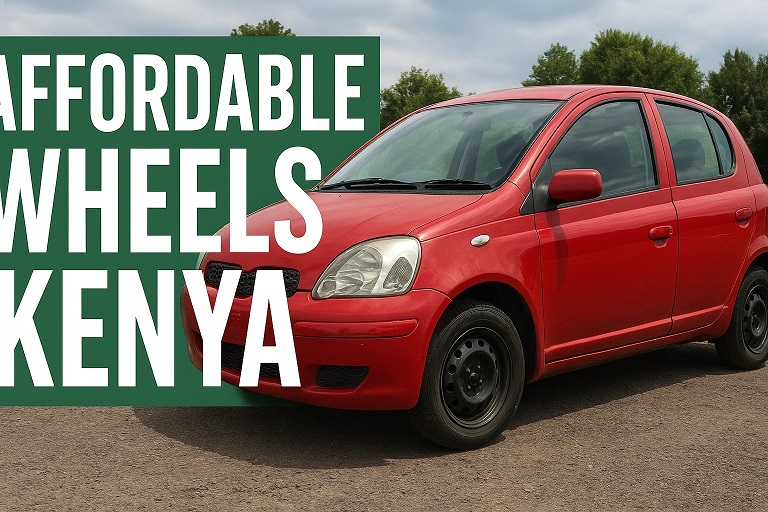

Titus Morebu
Author
How to Import a Car into Kenya: The Ultimate 2025 Guide 🚗
Learn the full step-by-step process, rules, costs, and tips to import a motor vehicle into Kenya—touring duty, age limits, clearance, registration.
Thinking of importing a car into Kenya? Whether you're a returning resident, expatriate, or simply hunting for a better deal overseas, this guide covers everything you need—from eligibility rules to taxes, clearance steps, registration, and smart tips. Let’s dive in! 🔧
1. Am I Eligible to Import a Car into Kenya?
Before getting excited about that dream ride, check these key eligibility rules:
- Age limit: Used vehicles must be less than 8 years old from the year of first registration. Vehicles older than that are generally rejected. (Special rules may apply when new regulations come into force).
- Right-hand drive only: Kenya restricts left-hand drive vehicles unless they serve special purposes (e.g. ambulances, fire tenders).
- Road-worthiness inspection: The vehicle must pass pre-shipment inspection by an accredited agency (such as QISJ) per KEBS / KS 1515:2000 standards.
- Duty-free for returning residents/diplomats (conditions apply): If you are a Kenyan citizen returning after residing abroad, or a diplomat, you may qualify to import one vehicle duty-free under certain strict criteria (e.g. you must have owned and used the car for at least 12 months, lived abroad for a defined period, and import within 90 days of arrival).
Returning Residents Duty-Free Conditions
To bring in a duty-free vehicle under this scheme, you generally must satisfy:
- Be aged 18 or older.
- Have lived outside Kenya for at least 2 years (and not visited Kenya for more than 90 days in aggregate during that period).
- The vehicle must have been registered in your name for at least 12 months.
- The import must happen within 90 days of your arrival in Kenya.
- It must still meet standard age and inspection rules.
2. Choosing the Right Vehicle
Some tips to avoid costly surprises:
- Prefer sellers or exporters that provide detailed inspection reports, service history, clear mileage, and good photos/video.
- Verify the vehicle’s logbook/documentation in the origin country; it must be clean, canceled (if used) and translated to English (if in another language).
- Avoid left-hand drive unless the vehicle is explicitly exempt from that rule.
- Consider shipping costs, insurance, and freight: these will be part of how your import value (CIF) is assessed.
- Always request a pre-shipment inspection via a recognized body (e.g. QISJ) before shipping; KRA will likely reject vehicles without this certification.
3. Understand the Import Costs & Taxes
Import costs in Kenya can be complex. Here’s the breakdown you should know:
3.1 CIF Value (Cost + Insurance + Freight)
KRA uses the CIF (cost of vehicle + insurance + freight) plus the greater of invoice value or a reference retail price (CRSP) as a base for valuation.
3.2 Import Duty
Import duty is typically **25%** of the CIF value. (The applicable rate may vary depending on the category of car.)
3.3 Excise Duty
Excise duty is applied on (Customs value + Import Duty). For some vehicles (depending on engine capacity) the excise rate may be 20%, while for others (higher cc) it may be 25%.
3.4 Value-Added Tax (VAT)
VAT is 16% on the sum of (Customs value + Import Duty + Excise Duty).
3.5 Other Charges
- Import Declaration Fee (IDF): 3.5% of CIF or a minimum flat amount (whichever is higher).
- Railway Development Levy (RDL): 2% of the CIF value.
3.6 Example Calculation
Let’s say your car’s CIF (cost + insurance + freight) is KES 1,000,000:
- Import duty (25%): KES 250,000
- Excise duty (say 20% on 1,250,000): KES 250,000
- VAT 16% on 1,500,000 (sum of CIF + duty + excise): KES 240,000
- IDF 3.5% of CIF = KES 35,000
- RDL 2% = KES 20,000
- Total tax & duty burden: ~ KES 795,000
Thus, your landed cost (before inspection, registration, etc.) is ~ KES 1,795,000 in this example.
4. Step-by-Step Import & Clearance Process
4.1 Pre-shipment Inspection & Export
Once you buy the vehicle, arrange for inspection (road-worthiness) via a certified body (QISJ or equivalent). The exporter ships the vehicle, issues the Bill of Lading, and you get all export/clearing documents.
4.2 Shipping to Kenya (Port of Entry)
Most vehicles arrive via the Port of Mombasa. Shipping may take 3–5 weeks depending on origin, route, vessel type (RORO vs container). Be aware of port delays, demurrage charges, and handling fees.
4.3 Hire a Licensed Clearing Agent
You’ll need a licensed customs clearing agent to lodge the import entry in KRA’s system, present documents, pay duties/fees, and request customs inspection and clearance.
4.4 Customs & KEBS/Inspection Clearance
Customs will inspect the vehicle, verify documents, and ensure conformity to standards. The vehicle must also comply with Kenya Bureau of Standards (KEBS / KS 1515) road-worthiness criteria. If the logbook is in a foreign language, an embassy or consulate in Kenya must translate/attest it.
4.5 Pay Duties and Get Release
Upon acceptance of your import entry and payments, the vehicle is cleared from customs. At this point, you’ll receive a customs release to move the vehicle to registration.
4.6 Registration with NTSA
The National Transport & Safety Authority (NTSA) must register the vehicle, issue Kenyan logbook, license plates, and roadworthiness certification for Kenyan roads.
5. Tips to Reduce Costs & Avoid Pitfalls
- Work with a trusted clearing agent who understands vehicle imports.
- Compare CIF + duty vs local market; sometimes local dealerships might be more cost-effective once you factor all hidden charges.
- Make sure your inspection certificate is valid and accepted by KRA (no cut corners).
- Avoid left-hand drive unless you have explicit exemption permission.
- Time your import to avoid excessive port storage/demurrage costs.
- For returning residents, ensure your timelines, ownership, and residence conditions are met to qualify for duty exemptions.
- Track regulatory changes: Kenya sometimes updates its vehicle import rules, age limits, and standards. Stay current.
6. Common Questions (FAQ)
How long does the import process take?
From purchase to delivery and registration, expect 4–8 weeks or more depending on shipping, customs, and registration queues.
Can I import a left-hand drive car?
Generally no, unless the vehicle is for special use (fire truck, ambulance, heavy machinery). Most regular cars must be right-hand drive.
Are electric or hybrid cars treated differently?
You still pay import duties, excise, VAT, etc. However, there is growing policy interest in green vehicles, so reduced rates or incentives may apply—confirm with KRA or clearing professionals.
Is it really cheaper to import than buy locally?
Often, yes—especially for rare or specific models—but after factoring taxes, inspection, shipping, and clearing, the savings may shrink. Many people report 10–20% savings if done correctly.
What happens if my vehicle is rejected at customs inspection?
It may be sent back, held, or reclassified. You may lose your deposit or pay penalties. Always ensure it meets the KEBS inspection standards beforehand.
7. Final Thoughts
Importing a car to Kenya is rewarding—but complex. The key to success is rigorous homework: vet the vehicle, ensure pre-shipment inspection, follow all legal requirements, and engage a competent agent. Do it properly, and you could land your ideal car at a better price than local options.
✅ Good luck with your import journey and safe driving on Kenyan roads!
Note: Always check Kenya Revenue Authority (KRA), KEBS, and NTSA for the very latest regulations as import rules may change.
Gallery

Related Articles
3 articles
Best Gyms in Nairobi & Their Membership Costs (2025 Guide)
Explore top gyms across Nairobi—facilities, membership fees, day passes, & tips for choosing your fit. 💪

Recommended Health & Wellness Tips for Kenyans
Live healthier through balanced diet, fitness, mental care & preventive habits — designed for life in Kenya 🌿

Affordable Wheels Kenya: Top Low-Cost Cars to Consider
Explore the most budget-friendly cars in Kenya — with tips, real prices, and what to watch out for when buying cheap wheels in 2025 🇰🇪